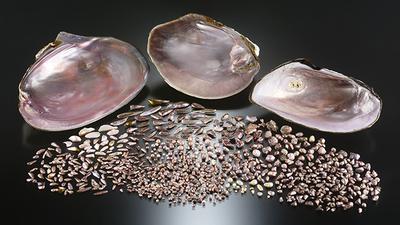Gemological and Chemical Characteristics of Natural Freshwater Pearls from the Mississippi River System

The natural freshwater pearls collected from the Mississippi River system, together with heelsplitter, purple wartyback or purple pimpleback, and bankclimber mussel shells. Photo by Diego Sanchez.
I was happy to loan some natural lavender USA river pearls to the GIA for this research article.
The Carlsbad laboratory received 854 natural freshwater pearls from Kari Anderson (Kari Pearls, Muscatine, Iowa), who stated that they were collected from the Mississippi River system (figure 1). Although the time and location of recovery and the mollusk species were not recorded, we were informed that all were recovered as a byproduct of the shelling business in the past couple of years. The samples ranged from 0.013 to 3.59 ct and measured from 1.63 × 1.19 mm to 9.87 × 8.52 × 5.89 mm. The shapes varied from baroque (the majority) to near-round, button, and oval. Many of the baroque pearls exhibited the unique “wing” or “feather” form (Anderson mentioned that the divers refer to these as “spike” pearls) typically associated with American natural freshwater pearls (J.L. Sweaney and J.R. Latendresse, “Freshwater pearls of North America,” Fall 1984 G&G, pp. 125–140). The wing pearls are elongated, with a roughly triangular shape, and usually taper to more pointed ends. Most possessed an uneven rippled surface along their lengths. The surface texture and shape of the wing pearls are identical to the lateral “teeth” areas found on the mussel shells that host these organic gems (figure 2, left).
The pearl colors also varied widely in hue, tone, and saturation. The range of hues included very light pink, purplish pink, orangy pink, brownish orange, and brownish purple to brown. Many displayed a pronounced orient effect (iridescence or multiple colors on or
The lightly colored samples exhibited moderate to strong yellow or bluish yellow fluorescence when exposed to long-wave ultraviolet radiation (365 nm), while the darker samples exhibited the same colors with weaker intensities. X-ray fluorescence imaging was used to help check the growth environment. The majority of the samples fluoresced weak to strong greenish yellow due to manganese content, thus confirming their freshwater origin. As with the long-wave UV reactions, the darker samples displayed weaker reactions, and this fluorescence quenching is related to the concentration of coloring pigments present (H. Hänni et al., “X-ray luminescence, a valuable test in pearl identification,” Journal of Gemmology, Vol. 29, No. 5/6, 2005, pp. 325–329). A few of the samples also exhibited a moderate to strong orangy reaction in some surface areas.
Read entire article here: https://bit.ly/2Pecasb
Join in and write your own page! It's easy to do. How? Simply click here to return to Pearl News.




